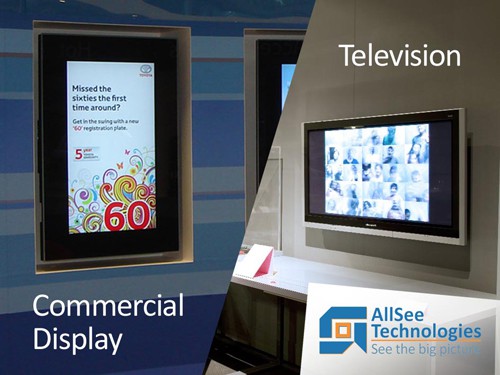
Digital Signage – “Can’t I just use a TV?”
When introducing new people to the world of digital signage I often get asked the question, “Can’t I just use a TV?”, and the simple answer is always, “Not if you want to gain the maximum benefit from your investment”. So just what are the differences and what benefits do commercial displays give and how can they be justified?
To begin to find answers we should start at the rational behind these products. According to POPAI, LG’s sponsored UK Digital Signage Survey, LCD screens are by far the most popular form of DOOH (Digital Out Of Home) advertising. Whereas commercial displays are specified and manufactured to meet the exacting demands of DOOH advertising, televisions are designed to be entertainment centres for use in the home.
What makes the out of home environment so different that it requires a specialist product? The answer is a matter of control. Outside the home there will be less control over the physical environment and who has access to the display. Also, a digital signage display will have to be constantly operating for long periods of time.
The physical environment requires having a higher brightness so as to be clearly seen over larger distances, together with a wide viewing angle to capture an audience walking past. These are issues that a television does not have to consider. So, also, are physical extremes of hot or cold that require digital advertising displays to have built in temperature controls. This allows constant operation that televisions are not designed for and may result in them overheating or having image retention problems. It is for these reasons that warranties of regular home TVs do no usually cover commercial use.
The look and styling of digital signage displays is very different to televisions. This is deliberate to gain attention from an audience that may ignore a ubiquitous TV playing on a wall. The most effective digital signage displays are unbranded, unlike TVs, to keep audience attention on the content and not who made the screen. Commercial displays also have their LCD panel enclosed by metal casing and tempered glass whereas TV and PC monitor LCD panels are usually exposed and are therefore more vulnerable.
TVs are designed for at home broadcasting, while digital displays are designed for narrowcasting, i.e. reaching your target audience. Internally a commercial display is different with an integrated media player and no requirement for a TV tuner. Commercial content can be displayed directly from an external media player or via memory storage devices (USB, Compact Flash, SD card). On a TV if someone doesn’t like the content being displayed, they change the channel, a TV is designed to be able to change channels or input devices easily – you don’t want this with a commercial display and so these have lockable compartments and no visible control buttons or panels. Additionally comprehensive digital signage solutions include content scheduling software to maximise versatility and provide targeted content through the use of playlists for different times of the day.
If the full potential of any digital out of home display is to be met then all factors must be considered, namely the fact that TVs are designed for home use and digital displays are designed for commercial use – it’s that simple.

Thomas Fraser-Bacon is the Marketing Director for Allsee Technologies. His background is in Digital Signage and Product Design.


